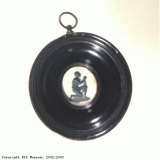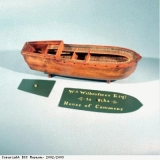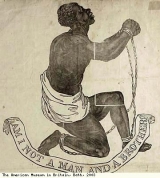The national campaign
From the late 18th century, there was growing concern in Europe and America over the slave trade. Violent slave rebellions were one reason for the change in attitude towards the slave trade. The growing humanitarian movement in Europe also contributed. The humanitarian movement campaigned for better human rights for those such as slaves, the poor and women (who also had few rights). The effects of these combined changes challenged the continuation of the trade. In Britain, a Parliamentary campaign for the abolition of the trade in slaves began in the 1780s and achieved its aim in 1807.
‘Abolition’ was the name given to the movement that wanted to end the slave trade. The Abolition movement linked men and women, black and white, businessmen and clergy, Christians and radicals, rich and poor, in a campaign against inhumanity. Pictured here is a ‘slave medallion’ made by Josiah Wedgwood, the potter, who was a supporter of the Abolition campaign. He made thousands of these ceramic medallions to be given away to raise awareness of the campaign. They were made into jewellery, set in boxes or framed to hang on the wall. There were many such items made around this time to spread the anti-slavery message.
Individuals had expressed concern about the slave trade for years. In 1615 Gerbrand Brederoo had written a poem against it, and in 1646 doctor and author Sir Thomas Browne wrote against it. The Quaker Society of Friends (a religious society known for its peaceful principles) had written against the slave trade. In 1760 the English Quaker movement ruled that anyone involved in slave trading could not remain a Quaker. Previously to this a number of Quakers had been prominent slave traders.
In 1785, Thomas Clarkson, a student at the University of Cambridge, wrote a prize-winning essay on the question ‘Is it right to make slaves of others against their will?’. Through this, he made contact with others opposed to the slave trade and the Committee for the Abolition of the Slave Trade was formed in 1787. The ‘logo’ of the campaign, pictured here, was first used by the Committee. It shows a kneeling slave in chains. The slogan of the campaign was ‘Am I not a man and a brother’. A similar logo was also used occasionally, with the words ‘Am I not a woman and a sister’.
The Committee for the Abolition of the Slave Trade set as its aim the abolition of the trade in slaves. That is, to stop the buying of enslaved Africans, their transportation from Africa, and their sale in the Caribbean plantations. The Committee did not campaign for the abolition of slavery itself, that is, to free the thousands of slaves on the plantations. This was because the Committee felt that they would have more success in achieving these tasks separately. It seemed more achievable to aim for ending the actual trade rather than aiming too high and risk gaining nothing.
Thomas Clarkson, from Wisbeach in Cambridgeshire, was the driving force behind the campaign to end the slave trade. He collected evidence against the slave trade by going to the ports of Liverpool and Bristol and talking to sailors about the conditions on board the slaving ships. William Wilberforce was the public face of the campaign. He was MP for Yorkshire in the north east of England, and used his position to speak out in Parliament, to push legislation and to campaign for Abolition. Wilberforce had a model made of a Liverpool slave ship. He used it at meetings to demonstrate how slaves were packed into the ships during the ‘middle passage’ across the Atlantic Ocean from Africa to the Caribbean. Pictured here is a copy of the model (the original is in Wilberforce House Museum in Hull). The model was of the Brookes, a Liverpool slave ship. On one voyage she had carried over 600 slaves. Some slave traders favoured ‘tight packing’, in which as many slaves as possible were carried, and though disease would spread rapidly, enough people would survive to make a profit for the investors. Other slave traders favoured ‘loose packing’, whereby fewer slaves were carried, disease was more controllable, and most of the ‘cargo’ arrived alive. The two methods of loading the slave ships gave the same profit to the traders.





